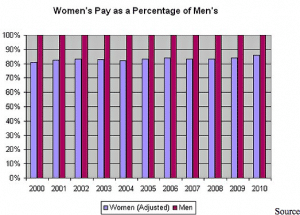Gender Gap on Wages Is Slow to Close
November 18, 2011
 By MOTOKO RICH for The New York Times – First, there was the “mancession” that made the downturn much worse for men. Then, what my colleague Catherine Rampell has called the “he-recovery,” which has put more men than women back to work. What has remained consistent is that women remain on the wrong side of the wage gap.
By MOTOKO RICH for The New York Times – First, there was the “mancession” that made the downturn much worse for men. Then, what my colleague Catherine Rampell has called the “he-recovery,” which has put more men than women back to work. What has remained consistent is that women remain on the wrong side of the wage gap.
Even with the same college and professional degrees, men earn more than women. And among so-called creative class workers like architects, teachers, artists, engineers, bankers and journalists, men earn much more than women, even though more women hold such jobs.
 It’s similar at the bottom end of the scale. According to a report issued Thursday by the United States Government Accountability Office, a higher proportion of women finish high school than men, a milestone that is a minimum requirement for any job mobility. Women — especially younger women — are also completing bachelor’s degrees at higher rates than men. Yet they represent a higher proportion of low-wage workers, defined in the report as those who earn hourly wage rates that put them in the bottom 20 percent of the work force.Source: Government Accountability Office analysis of Current Population Survey data
It’s similar at the bottom end of the scale. According to a report issued Thursday by the United States Government Accountability Office, a higher proportion of women finish high school than men, a milestone that is a minimum requirement for any job mobility. Women — especially younger women — are also completing bachelor’s degrees at higher rates than men. Yet they represent a higher proportion of low-wage workers, defined in the report as those who earn hourly wage rates that put them in the bottom 20 percent of the work force.Source: Government Accountability Office analysis of Current Population Survey data
So although women make up 49 percent of the total work force, they represent 59 percent of low-wage workers. (That is down from 63 percent a decade ago.)
When women do not complete high school, they earn less than men who do not have a high school diploma. Undereducated women tend to congregate in occupations that pay less than those taken by men. Women are highly represented in health care and social assistance, for example, where their average wages are about $14 an hour. Men take jobs in construction, transportation or utilities, where their average wages are more than $19 an hour.
Yet such occupational variations cannot fully account for the wage gap. Neither can the fact that women are more likely to work part time than men.
Adjusted for factors that could affect pay, like age, race, education, number of children in the household and part-time status, women earn 86 cents for every $1 earned by men. That’s up from 81 cents in 2000.
Source: Government Accountability Office analysis of Current Population Survey data
But the study, based on an analysis of Labor Department data, could not determine whether other factors, like previous work experience or other choices made by women in the workplace, were keeping their wages from achieving closer parity, or whether there was still some other discriminatory effect.
Senator Robert P. Casey Jr., chairman of the Joint Economic Committee of Congress, which commissioned the G.A.O. report, said that he was surprised that despite higher levels of education, the gap between men’s and women’s pay hadn’t narrowed much more. “I would have said we would have seen more progress,” said Senator Casey, a Pennsylvania Democrat.
He said the findings made the need for Congressional action on job creation more acute. “Every week that goes by where you don’t have progress on those measures is obviously going to make the situation worse for everyone,” he said. “But low-wage workers are having some of the most difficult challenges, and those challenges just get more significant.”
NOTE: Thanks to the Tennessee Economic Council on Women for sending this article to ElectWomen Magazine. The council’s similar research was recently presented at this year’s Economic Summit for Women.
